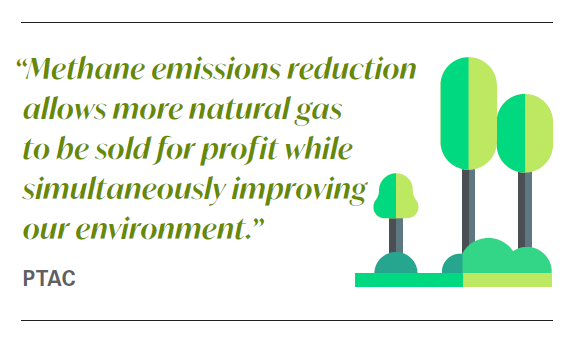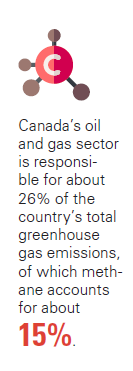Meeting the methane challenge [Gas in Transition]
At last November’s COP26 summit in Scotland, the EU and the US led more than 100 countries in the creation of the Global Methane Pledge, which aims to cut methane emissions by 30% from 2020 levels by 2030.
Delivering on that goal, pledge advocates said, would reduce global warming “by at least 0.2°C by 2050, providing a crucial foundation for global climate change mitigation efforts.”
But a Canadian research collaborative, the Petroleum Technology Alliance of Canada, or PTAC, has been working for more than two decades to bring methane-reduction technologies to the market, and its efforts, according to a year-end report released in December, are already responsible for a 45% reduction in methane emissions from the oil and gas sector – with more to come.
PTAC re-focused its efforts on reducing methane emissions more than a decade ago, when it helped create the Methane Emission Reduction Network (MERN), with a vision to build methane detection, quantification, monitoring and mitigation technologies. Its short-term goal, PTAC says in its Methane Detection and Mitigation Initiatives Report, is to build enough technology capacity in Canada to reduce 45% of 2012 methane emissions at a cost of less than C$5/mt of CO2-equivalent (CO2e) by 2022. Longer-term, it wants to achieve a 90% reduction by 2030.
In 2019, Canada reported 730mn mt CO2e of greenhouse gas emissions in its National Inventory Report, with the oil and gas sector accounting for 26%, or 191mn mt CO2e. Of the Canadian total, about 15% of the carbon-equivalent emissions are in the form of methane, and those are the target of PTAC’s research efforts.
Working in collaboration with the pan-Canadian Clean Resource Innovation Network (CRIN) and the federal government’s Canadian Emissions Reduction Innovation Network (CERIN), PTAC has launched more than 40 applied research projects to help oil and gas producers develop cost effective and accurate detection and mitigation best practices.
Those collaborations, PTAC CEO Soheil Asgarpour tells NGW, have been instrumental in PTAC achieving its goals.
“Collaboration with all stakeholders – producers, government organisations, technology providers, academic and research organisations and regulatory bodies – and in particular with CERIN and CRIN, has been extremely important in methane detection and mitigation successes,” he says.
The research that has been conducted under the CRIN and CERIN umbrellas, PTAC says in its year-end report, have yielded a “tsunami” of methane emissions data from a wide range of detection technologies deployed on the ground and in the air.
“By developing statistical and simulation models, PTAC is helping producers to gain insight of the trends in methane emissions from various sources, optimising the implementation of new technologies in fugitive emissions management programs to achieve mitigation targets at the lowest cost, and guiding technology development and commercialisation,” the report notes. “These technologies are not only currently reducing methane emission in Canada but also are helping global reduction of methane emissions.”
Carbon capture and storage (CCS) options are gaining increasing traction as a critical component to ensure the sustainability of oil and gas production. But PTAC says reducing methane emissions remains the lynchpin for achieving fast and cost-effective reductions of greenhouse gas (GHG) emissions.
CCS costs, it says, start at C$50/mt of CO2-equivalent (CO2e), and can rise to $170/mt or higher. But reducing methane emissions starts at a negative cost and increases to “significantly below” C$50/mt of CO2e. And methane, unlike captured and stored CO2, has commercial value: “we can sell methane,” PTAC says.
“Methane emissions reduction allows more natural gas to be sold for profit while simultaneously improving our environment,” it says. “Methane is the catalyst where traditional oil and gas and leading-edge cleantech meet. It has the potential to forever change how we do business by helping Canadian small- and medium-sized cleantech companies prosper nationally and internationally.”
Over the past 15 years, Asgaspour says, PTAC has helped secure funding for nine small and medium-sized enterprises (SMEs) to develop their technologies. Collectively, those nine projects have the capacity to reduce methane emissions by 37%.
But more importantly, Asgarpour says, they have helped address the largest challenge faced by SMEs: ‘The Valley of Death’.
“This refers to the significant challenge of moving early development stage technologies to a point where they can be commercialised,” PTAC’s report says. “Numerous technologies have failed to move to the latter commercialisation stages – hence ‘The Valley of Death’.”
In 2017, PTAC decided it was time to take a more systematic approach to ensuring that new technologies make it through the Valley of Death and created a consortium of field-testing facilities, the Canadian Emissions Reduction Innovation Consortium (CanERIC). Through CanERIC, 14 oil and gas producers and 16 universities and research centres in Canada and the US have dedicated their field and lab facilities, worth more than $1bn, to the effort.
In the past, Asgarpour says, SMEs who wanted their technologies field-tested had to knock on many producers’ doors, and since they had little knowledge of field operations challenges faced by the producers, they had little success getting any traction with those producers.
“Furthermore, producers were overwhelmed with the task of screening and assessing potential SMEs’ technologies, since a technology would have to be assessed many times by various producers,” he notes. “CanERIC overcomes those challenges by providing a ‘one-stop shop’ for innovators to access a full range of specialised field and lab testing facilities located across Canada.”
Besides screening emerging technologies and evaluating them on a socio-economic basis to assess both their technical viability and their economic feasibility, CanERIC hosts an open information-sharing platform to help avoid duplication and close field-testing gaps.
“The oil and gas industry currently lacks streamlined support for critically needed novel, high performance and cost-effective technologies to address the global emissions reduction challenge,” Asgarpour says. “CanERIC responds to this industry gap through increased research collaboration, commercial cost-effective methane detection and mitigation technologies, creation of new intellectual property, training of the next generation of technicians and professionals, acceleration of commercialisation, and national and international market growth.”
So far, three technologies have been lab-tested, nine have been developed and/or field-tested, and six are under various testing protocols. Collectively, 21 technologies tested through PTAC and CanERIC have the capacity to reduce oil and gas sector methane emissions by 48%.
But PTAC’s involvement doesn’t end with field testing. It also helps SMEs face the challenge of increasing market uptake of their methane reduction solutions through the creation of two consortia which together will pay up to 75% of the cost of equipment and installation of cost-effective mitigation technologies.
This programme has resulted in the installation of 101 pieces of equipment, the PTAC report says, including 10 site electrifications, 37 pump optimisations, 26 smart pumps, 14 standard electric pumps, 12 instrument air compressors, one “facility of the future” and one compressor engine. Cumulative methane emission reductions are approaching 90,000 mtCO2e.
But this is just the tip of the proverbial iceberg: PTAC estimates suggest the potential for the mass deployment of at least 5,000 site electrifications, 5,000 pump optimisations, 5,000 instrument air compressors, 10,000 smart chemical pumps, 10,000 standard electric chemical pumps and 500 compressor engines. In short, Asgarpour says, technology PTAC is supporting today can easily make its way around the world tomorrow.
“As we continue working in collaboration with this oil and gas innovation ecosystem, we will help maintain Canada’s position as the global methane detection and mitigation leader, and support the creation of clean tech jobs and the adoption and international utilisation of Canadian technology.”



